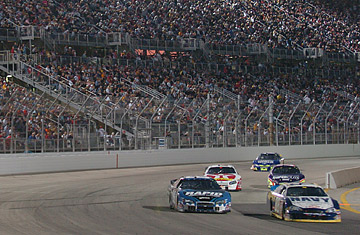
Millions of fans have made NASCAR one of the biggest sports in the world
(2 of 2)
How can NASCAR position itself to motor through the downturn? The sport has to start with its costs, which exploded during NASCAR's stunning growth spurt earlier this decade. "The old adage was, If you need $1 million in expenses, go get $1 million in sponsorship," says Mike Dee, president of Fenway Sports Group, which owns 50% of the Roush Fenway Racing team. "The railroad doesn't run that way now."
NASCAR has already aggressively trimmed expenses. Like many companies, teams have turned to layoffs: 600 to 800 workers from Sprint Cup teams have been let go since the end of last season. "It has served to cull the flock," says Steve Kalik, a team manager for Specialty Racing in NASCAR's second-tier Nationwide series. NASCAR also banned testing prior to Daytona and during the season, essentially R&D time for the cars at its sanctioned tracks for the 2009 season. France estimates the ban will save teams $30 million. (See pictures of custom big rigs.)
A good portion of the cutbacks can be attributed to the sport's success. "A couple or three years ago, you had so many new teams coming in," says team owner Rick Hendrick, who fields cars for Jimmie Johnson, Jeff Gordon and Dale Earnhardt Jr. "You had Toyota coming in with new teams, and there were so many people planning on running multiple teams that the pool of people moving in and being trained just kept growing and growing and growing. It looked like there was no end in sight. All of a sudden, teams can't find sponsors, they shut down and go out of business, and all of a sudden those people are out looking."
The decrease in demand for workers and parts does have an upside for those still in the race. "The parts we buy are in some instances half-price from last year, so your $600,000 engine program may cost $300,000 this year," says Kalik. "Same engine, same everything — just tremendously less demand. Therefore the engine builders and chassis builders are hungry for the dollar, so they'll work for less."
The tracks are also discounting to spur foot traffic. At Daytona, the cost of backstretch seats was reduced from $95 to $55, the lowest price since 1995. Race organizers negotiated with local hotels to eliminate minimum-five-day stays. Organizers in Charlotte, N.C., have also persuaded the city's hotels to reduce rates for the two Sprint Cup races at Lowe's Motor Speedway (LMS). According to LMS president Marcus Smith, the track not only dropped prices in some sections but also refunded the difference to fans who had already purchased, an effort, he says, to show loyalty to the customers who have helped build the sport. In Texas, prices for hot dogs, hamburgers and barbecue sandwiches have all dropped. "These are all staples, things people want," says Gossage. "We're not cutting the price of licorice whips."
Of course, discounts present their own dangers for all sports fighting the recession. Unless the price entices a sufficient amount of extra customers, you lose revenue. And those who do come to the track may expect a lower price in the future. So you risk alienating those fans when you try to boost the bottom line down the road. "It's a slippery slope," says David Carter, executive director of the Sports Business Institute at the University of Southern California. "If the consumer lowers the threshold, it's harder to get back to the true market price. It's a decent short-term strategy that can wreak havoc in the long term." International Speedway, for one, insists the deals will stick around for some time. "We're doing a price-resetting," says chief marketing officer Daryl Wolfe. "We're not talking about a quick-and-dirty discount."
NASCAR's popularity exploded, in part, because it's one of the more fan-friendly major sports in the country. The drivers are often remarkably accessible, even signing autographs for fans on race days. NASCAR may need to get even cozier with them. As NASCAR raced to the top of the American sporting scene, it might have taken its base a bit for granted. "We need to engage the fans with more passion," says driver Jeff Burton, a 17-year Sprint Cup veteran. "We need to be creative, to come up with better ideas." One thought officials are kicking around right now: sending drivers to local markets weeks, even months, before race day to make appearances and create buzz. "Just because we did it a certain way for five years doesn't mean we have to keep it up," says Wolfe. "Let's turn it upside down."
Even in the face of unprecedented challenges, NASCAR has plenty of horsepower. The sport is three years into an eight-year, $4.5 billion television deal with Fox, ESPN/ABC and TNT. The steady TV revenue can help cushion sponsorship losses. NASCAR is still the second highest rated regular-season sport on television. Plus, the sport has even signed up some new partners, like Ask.com and O'Reilly Auto Parts. Companies such as Mars Inc. and DuPont renewed their deals. And still others want to get into the game. During the recent NASCAR media tour, France noted that 15 new teams had submitted chassis for approval.
Still, NASCAR can't afford to idle its engines when consumer spending is so dismal. "What we have to do is make sure the passionate fan becomes more passionate," says Burton. "We have to make sure the casual fan becomes the passionate fan." There's just one crucial thing Burton and NASCAR can't do for their fans. They can't drop more cash in their pockets.
